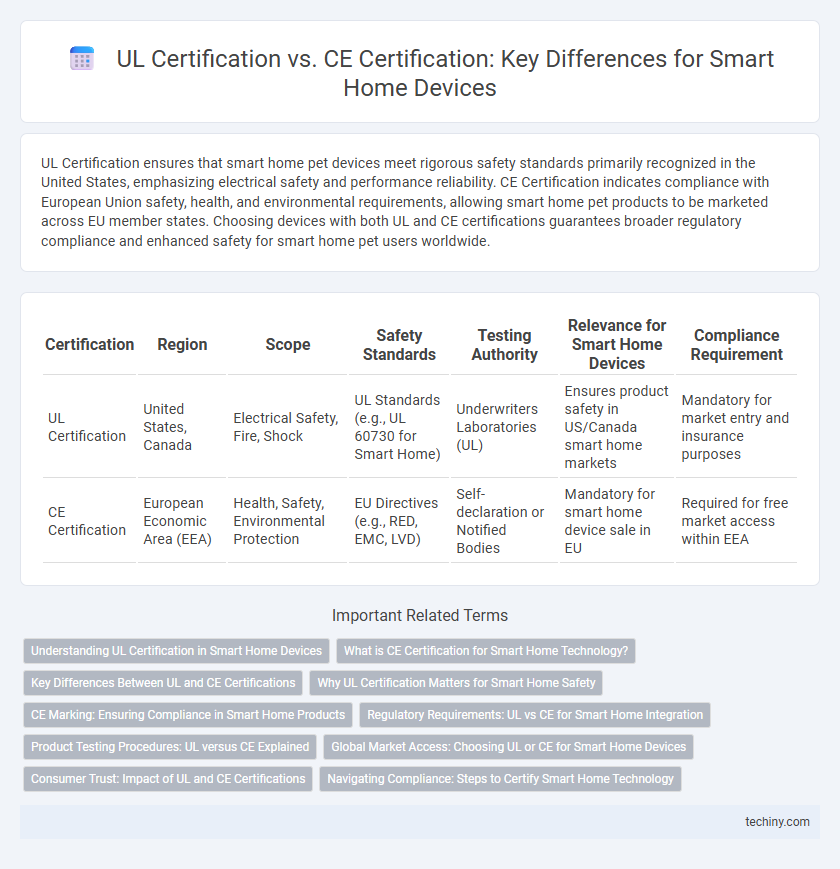UL Certification ensures that smart home pet devices meet rigorous safety standards primarily recognized in the United States, emphasizing electrical safety and performance reliability. CE Certification indicates compliance with European Union safety, health, and environmental requirements, allowing smart home pet products to be marketed across EU member states. Choosing devices with both UL and CE certifications guarantees broader regulatory compliance and enhanced safety for smart home pet users worldwide.
Table of Comparison
| Certification | Region | Scope | Safety Standards | Testing Authority | Relevance for Smart Home Devices | Compliance Requirement |
|---|---|---|---|---|---|---|
| UL Certification | United States, Canada | Electrical Safety, Fire, Shock | UL Standards (e.g., UL 60730 for Smart Home) | Underwriters Laboratories (UL) | Ensures product safety in US/Canada smart home markets | Mandatory for market entry and insurance purposes |
| CE Certification | European Economic Area (EEA) | Health, Safety, Environmental Protection | EU Directives (e.g., RED, EMC, LVD) | Self-declaration or Notified Bodies | Mandatory for smart home device sale in EU | Required for free market access within EEA |
Understanding UL Certification in Smart Home Devices
UL Certification for smart home devices ensures rigorous safety and performance standards specific to the North American market, verifying products meet stringent electrical and fire hazard requirements. This certification involves thorough testing for durability, electromagnetic compatibility, and cybersecurity vulnerabilities to protect users in interconnected environments. CE Certification, primarily for the European market, focuses on conformity with EU directives but does not offer the same depth of safety assurance as UL regarding smart home device reliability and user protection.
What is CE Certification for Smart Home Technology?
CE Certification for smart home technology ensures products comply with European Union safety, health, and environmental protection standards. It signifies that devices such as smart thermostats, security cameras, and lighting systems meet stringent performance and electromagnetic compatibility requirements. This certification is mandatory for market access within the European Economic Area, guaranteeing consumer safety and product reliability.
Key Differences Between UL and CE Certifications
UL Certification primarily focuses on safety standards for products used in the United States and Canada, emphasizing rigorous testing for electrical and fire hazards in smart home devices. CE Certification indicates conformity with European Union health, safety, and environmental protection standards, ensuring smart home products meet essential directives like EMC and low voltage without specific safety testing. The key difference lies in UL's emphasis on safety testing within North America, while CE serves as a regulatory declaration for market access across the European Economic Area.
Why UL Certification Matters for Smart Home Safety
UL Certification ensures smart home devices meet rigorous safety standards established by Underwriters Laboratories, reducing the risk of electrical hazards and fire. This certification involves thorough testing for performance, reliability, and compliance with North American safety regulations, making it essential for products used in homes. CE Certification primarily addresses European market requirements, but UL Certification is crucial for protecting consumers in the U.S. and Canada through verified safety assurance.
CE Marking: Ensuring Compliance in Smart Home Products
CE Marking certifies that smart home products comply with European Union safety, health, and environmental protection standards, enabling free market access within the EU. It ensures interoperability and reduces risks related to electromagnetic compatibility and product safety for devices such as smart thermostats, lighting systems, and security sensors. Unlike UL Certification, which focuses primarily on North American standards, CE certification targets regulatory compliance essential for manufacturers aiming to enter the European smart home market.
Regulatory Requirements: UL vs CE for Smart Home Integration
UL certification ensures smart home devices comply with rigorous safety and performance standards predominantly recognized in North America, emphasizing electrical safety, fire hazards, and electromagnetic compatibility. CE certification is mandatory for smart home products sold within the European Economic Area, focusing on conformity with health, safety, and environmental protection directives. Meeting UL standards facilitates market entry in the US and Canada, while CE marking is essential for legal distribution and consumer trust across Europe.
Product Testing Procedures: UL versus CE Explained
UL Certification requires rigorous product testing focused on safety standards specific to North America, including electrical, fire, and environmental hazards, ensuring compliance through detailed laboratory evaluations and on-site inspections. CE Certification demonstrates conformity with European Union directives, emphasizing essential health, safety, and environmental requirements, achieved through self-assessment or third-party testing based on product risk categories. Both certifications involve comprehensive testing procedures, but UL emphasizes in-depth third-party evaluation while CE often allows manufacturer-led conformity assessments.
Global Market Access: Choosing UL or CE for Smart Home Devices
UL Certification ensures compliance with stringent safety standards primarily recognized in North America, enhancing market access in the United States and Canada for smart home devices. CE Certification demonstrates conformity with European Union regulations, enabling seamless entry into the extensive European market. Selecting between UL and CE certifications depends on target regions, with UL suited for North American distribution and CE essential for European market access.
Consumer Trust: Impact of UL and CE Certifications
UL Certification ensures smart home devices meet rigorous safety standards recognized primarily in North America, boosting consumer confidence through verified product reliability and risk reduction. CE Certification demonstrates compliance with European Union safety, health, and environmental protection standards, assuring consumers of product conformity with stringent regulatory requirements across Europe. Both certifications significantly enhance consumer trust by validating product safety, facilitating market access, and reducing liability concerns in their respective regions.
Navigating Compliance: Steps to Certify Smart Home Technology
Navigating compliance for smart home technology requires understanding the specific requirements of UL Certification and CE Certification, as each assesses product safety and performance within different regulatory frameworks. UL Certification focuses on meeting rigorous safety standards primarily for the North American market, emphasizing fire, electrical, and mechanical safety in connected devices. CE Certification is mandatory for products entering the European Economic Area, ensuring conformity with health, safety, and environmental regulations through harmonized EU directives.
UL Certification vs CE Certification Infographic

 techiny.com
techiny.com